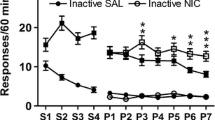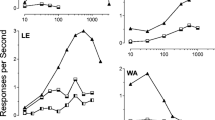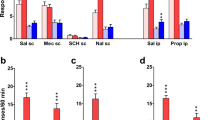Abstract
Rationale and objective
Intravenous infusions of nicotine appear to exert little primary reinforcing effects in adult rats but, instead, maintain self-administration behavior at least, in part, by increasing the intrinsic reinforcing effects of drug-paired sensory stimuli. The present study examined instead the impact of a motivationally neutral cue on self-administration.
Methods
Adult male Long-Evans rats were permitted to self-administer nicotine (0.015 mg/kg IV given over 30 s, 2 h/day) or saline presented with or without a sensory stimulus (light, white noise). Fixed and progressive ratio reinforcement schedules of nicotine reinforcement were tested. Experiment 2 determined whether noncontingent nicotine or mecamylamine (nicotinic antagonist) would induce lever pressing for either sensory stimulus. Experiment 3 tested whether the white noise stimulus alone could maintain responding after repeated pairing with self-administered nicotine. Finally, the sensory stimuli were assessed for possible aversive properties.
Results
Nicotine infusions alone were at best weakly reinforcing. The white noise stimulus, presented alone, was neither reinforcing nor aversive, whereas the white light appeared marginally reinforcing. Both stimuli, however, facilitated intravenous nicotine self-administration. Neither nicotine nor mecamylamine challenge rendered the white noise reinforcing. The white noise, after being self-administered with nicotine, failed to maintain self-administration behavior on its own.
Conclusions
Even a motivationally neutral sensory stimulus, lacking detectable primary or secondary reinforcing properties, can facilitate self-administration of nicotine. Possibly, drug-paired stimuli provide a "response marker" or serve as a temporal bridge between the operant response and drug effect. Motivationally neutral stimuli may therefore serve to isolate primary reinforcing effects of nicotine.





Similar content being viewed by others
Abbreviations
- DA:
-
dopamine
- FR:
-
fixed ratio
- PR:
-
progressive ratio
References
Brunzell DH, Chang JR, Schneider B, Olausson P, Taylor JR, Picciotto MR (2006) Beta2-subunit-containing nicotinic acetylcholine receptors are involved in nicotine-induced increases in conditioned reinforcement but not progressive ratio responding for food in C57BL/6 mice. Psychopharmacology (Berl) 184:328–338
Caggiula AR, Donny EC, White AR, Chaudhri N, Booth S, Gharib MA, Hoffman A, Perkins KA, Sved AF (2002) Environmental stimuli promote the acquisition of nicotine self-administration in rats. Psychopharmacology (Berl) 163:230–237
Caggiula AR, Donny EC, Palmatier MI, Liu X, Chaudhri N, Sved AF (2009) The role of nicotine in smoking: a dual-reinforcement model. Nebr Symp Motiv 55:91–109
Chaudhri N, Caggiula AR, Donny EC, Booth S, Gharib MA, Craven LA, Allen SS, Sved AF, Perkins KA (2005) Sex differences in the contribution of nicotine and nonpharmacological stimuli to nicotine self-administration in rats. Psychopharmacology (Berl) 180:258–266
Chaudhri N, Caggiula AR, Donny EC, Booth S, Gharib M, Craven L, Palmatier MI, Liu X, Sved AF (2006a) Operant responding for conditioned and unconditioned reinforcers in rats is differentially enhanced by the primary reinforcing and reinforcement-enhancing effects of nicotine. Psychopharmacology (Berl) 189:27–36
Chaudhri N, Caggiula AR, Donny EC, Palmatier MI, Liu X, Sved AF (2006b) Complex interactions between nicotine and nonpharmacological stimuli reveal multiple roles for nicotine in reinforcement. Psychopharmacology (Berl) 184:353–366
Chaudhri N, Caggiula AR, Donny EC, Palmatier MI, Liu X, Sved AF (2006c) Complex interactions between nicotine and nonpharmacological stimuli reveal multiple roles for nicotine in reinforcement. Psychopharmacology (Berl) 184:353–366
Chaudhri N, Caggiula AR, Donny EC, Booth S, Gharib M, Craven L, Palmatier MI, Liu X, Sved AF (2007) Self-administered and noncontingent nicotine enhance reinforced operant responding in rats: impact of nicotine dose and reinforcement schedule. Psychopharmacology (Berl) 190:353–362
Clarke PB, Kumar R (1984) Effects of nicotine and d-amphetamine on intracranial self-stimulation in a shuttle box test in rats. Psychopharmacology (Berl) 84:109–114
Cohen C, Perrault G, Griebel G, Soubrie P (2005) Nicotine-associated cues maintain nicotine-seeking behavior in rats several weeks after nicotine withdrawal: reversal by the cannabinoid (CB1) receptor antagonist, rimonabant (SR141716). Neuropsychopharmacology 30:145–155
Donny EC, Chaudhri N, Caggiula AR, Evans-Martin FF, Booth S, Gharib MA, Clements LA, Sved AF (2003) Operant responding for a visual reinforcer in rats is enhanced by noncontingent nicotine: implications for nicotine self-administration and reinforcement. Psychopharmacology (Berl) 169:68–76
Goldberg SR, Spealman RD, Goldberg DM (1981) Persistent behavior at high rates maintained by intravenous self-administration of nicotine. Science 214:573–575
Liu X, Caggiula AR, Yee SK, Nobuta H, Poland RE, Pechnick RN (2006) Reinstatement of nicotine-seeking behavior by drug-associated stimuli after extinction in rats. Psychopharmacology (Berl) 184:417–425
Liu X, Palmatier MI, Caggiula AR, Donny EC, Sved AF (2007) Reinforcement enhancing effect of nicotine and its attenuation by nicotinic antagonists in rats. Psychopharmacology (Berl) 194:463–473
Manzardo AM, Stein L, Belluzzi JD (2002) Rats prefer cocaine over nicotine in a two-lever self-administration choice test. Brain Res 924:10–19
Matta SG, Balfour DJ, Benowitz NL, Boyd RT, Buccafusco JJ, Caggiula AR, Craig CR, Collins AC, Damaj MI, Donny EC, Gardiner PS, Grady SR, Heberlein U, Leonard SS, Levin ED, Lukas RJ, Markou A, Marks MJ, McCallum SE, Parameswaran N, Perkins KA, Picciotto MR, Quik M, Rose JE, Rothenfluh A, Schafer WR, Stolerman IP, Tyndale RF, Wehner JM, Zirger JM (2007) Guidelines on nicotine dose selection for in vivo research. Psychopharmacology (Berl) 190:269–319
Olausson P, Jentsch JD, Taylor JR (2004a) Nicotine enhances responding with conditioned reinforcement. Psychopharmacology (Berl) 171:173–178
Olausson P, Jentsch JD, Taylor JR (2004b) Nicotine enhances responding with conditioned reinforcement. Psychopharmacology (Berl) 171:173–178
Olausson P, Jentsch JD, Taylor JR (2004c) Repeated nicotine exposure enhances responding with conditioned reinforcement. Psychopharmacology (Berl) 173:98–104
Palmatier MI, Evans-Martin FF, Hoffman A, Caggiula AR, Chaudhri N, Donny EC, Liu X, Booth S, Gharib M, Craven L, Sved AF (2006) Dissociating the primary reinforcing and reinforcement-enhancing effects of nicotine using a rat self-administration paradigm with concurrently available drug and environmental reinforcers. Psychopharmacology (Berl) 184:391–400
Palmatier MI, Liu X, Matteson GL, Donny EC, Caggiula AR, Sved AF (2007a) Conditioned reinforcement in rats established with self-administered nicotine and enhanced by noncontingent nicotine. Psychopharmacology (Berl) 195:235–243
Palmatier MI, Matteson GL, Black JJ, Liu X, Caggiula AR, Craven L, Donny EC, Sved AF (2007b) The reinforcement enhancing effects of nicotine depend on the incentive value of non-drug reinforcers and increase with repeated drug injections. Drug Alcohol Depend 89:52–59
Picciotto MR, Addy NA, Mineur YS, Brunzell DH (2008) It is not "either/or": activation and desensitization of nicotinic acetylcholine receptors both contribute to behaviors related to nicotine addiction and mood. Prog Neurobiol 84:329–342
Pratt JA, Stolerman IP, Garcha HS, Giardini V, Feyerabend C (1983) Discriminative stimulus properties of nicotine: further evidence for mediation at a cholinergic receptor. Psychopharmacology (Berl) 81:54–60
Raiff BR, Dallery J (2008) The generality of nicotine as a reinforcer enhancer in rats: effects on responding maintained by primary and conditioned reinforcers and resistance to extinction. Psychopharmacology (Berl) 201:305–314
Rescorla RA (1982) Effect of a stimulus intervening between CS and US in autoshaping. J Exp Psychol Anim Behav Processes 8:131–141
Rose JE, Behm FM, Westman EC, Coleman RE (1999) Arterial nicotine kinetics during cigarette smoking and intravenous nicotine administration: implications for addiction. Drug Alcohol Depend 56:99–107
Sorge RE, Clarke PB (2009) Rats self-administer intravenous nicotine delivered in a novel smoking-relevant procedure: effects of dopamine antagonists. J Pharmacol Exp Ther 330:633–640
Stewart J (1960) Reinforcing effects of light as a function of intensity and reinforcement schedule. J Comp Physiol Psychol 53:187–193
Stewart J, Hurwitz HMB (1958) Studies in light-reinforced behaviour III. The effect of continuous, zero and fixed-ratio reinforcement. J Comp Physiol Psychol 10:56–61
Stolerman IP, Jarvis MJ (1995) The scientific case that nicotine is addictive. Psychopharmacology (Berl) 117:2–10 discussion 14-20
United States Department of Health and Human Services U (1988) Nicotine addiction: a report of the surgeon general. Office of the Assistant Secretary for Health, Office on Smoking and Health, Rockville, MD
Williams BA (1994) Conditioned reinforcement: neglected or outmoded explanatory construct? Psychon Bull Rev 1:457–475
Acknowledgements
This study is supported by a Natural Science and Engineering Research Council of Canada Post-Doctoral Fellowship (R.E.S.), a Canadian Institutes of Health Research of Canada operating grant (MOP-10516, to P.B.SC), and a Canadian Tobacco Control Research Initiative ICE Team Grant (to P.B.SC). Declaration: all experiments reported here comply with the current laws of Canada, and the authors have no financial relationship with the organizations that sponsored this research.
Author information
Authors and Affiliations
Corresponding author
Rights and permissions
About this article
Cite this article
Sorge, R.E., Pierre, V.J. & Clarke, P.B.S. Facilitation of intravenous nicotine self-administration in rats by a motivationally neutral sensory stimulus. Psychopharmacology 207, 191–200 (2009). https://doi.org/10.1007/s00213-009-1647-8
Received:
Accepted:
Published:
Issue Date:
DOI: https://doi.org/10.1007/s00213-009-1647-8




